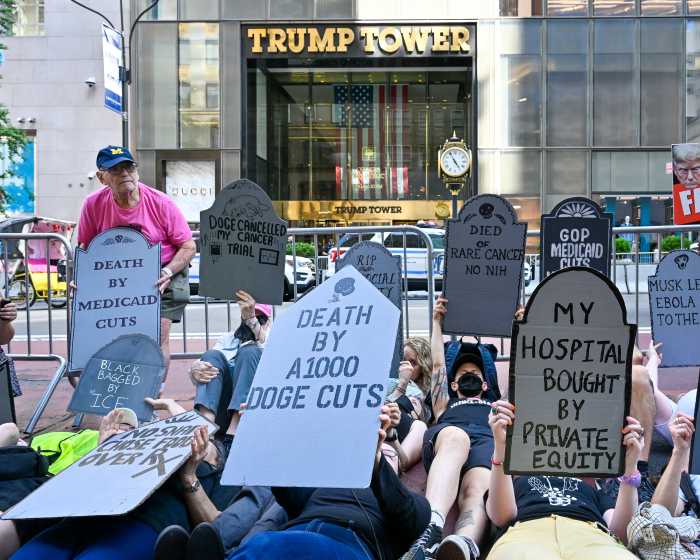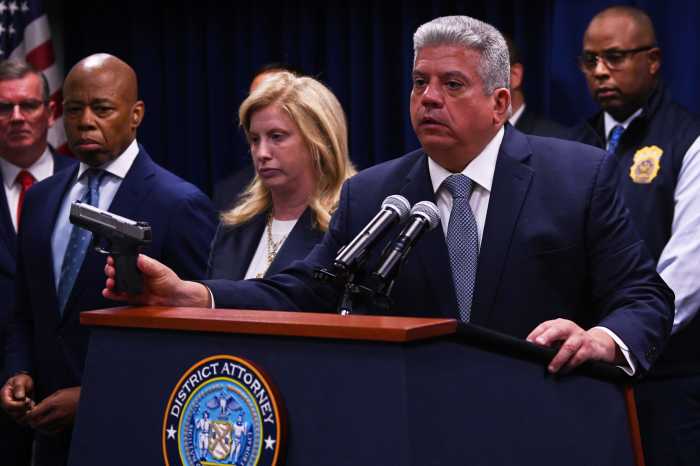
Call it Amazon HQ2 . . . divided by two? The online retail giant plans to split its second U.S. headquarters between Long Island City, Queens and Arlington, Virginia.
The new campuses are each expected to generate 25,000 jobs and hiring is set to begin in 2019.
"We are excited to build new headquarters in New York City and Northern Virginia,” Jeff Bezos, founder and CEO of Amazon, said during the announcement on Nov. 13. “These two locations will allow us to attract world-class talent that will help us to continue inventing for customers for years to come.”
The decision comes about a year after Amazon announced it was on the hunt for a location to set up a second headquarters. Initially Amazon, which is based in Seattle, had said it would choose one location that would staff up to 50,000 employees.
Amazon received 238 bids from cities across the country vying to expand their presence in the lucrative tech industry. The online retailer had narrowed the list of finalists down to 20, including New York City, in January.
The selection of Long Island City, however, has garnered both praise and criticism from local politicians and residents, particularly with regard to the generous tax breaks the company received in the deal.
A Quinnipiac University poll released on Dec. 5 found that while a majority of New York City residents support Amazon’s LIC HQ2 (57-26), New Yorkers are decidedly split (46-44) over the tax breaks the state offered.
Learn more about what Amazon plans to do, what the impact on Long Island City could be, how local politicians are reacting to the announcement and more.
Say what? Why Amazon split its second headquarters
Amazon said it chose to divide its second headquarters between two locations because it would greatly expand the company’s ability to recruit top talent while lessening the potential negative impacts that a 50,000-person campus could have on congestion and cost-of-living increases.

Amazon enticed by diversity, cultural institutions and . . . breweries
The campus will be located along Long Island City’s waterfront, across the East River from Manhattan’s Midtown East neighborhood. A map of the campus shows Amazon’s headquarters is expected to be built east of Vernon Boulevard between 44th and 46th avenues.
Although no specific addresses were released, Amazon has agreed to open a 4-million-square foot energy-efficient office space within 10 years. The campus will expand to between 6 and 8 million square feet within 15 years, according to documents related to the deal with the city and state.
In its announcement, Amazon highlighted the neighborhood’s diverse community, cultural institutions, schools, housing options, restaurants and bars, greenspaces and even its breweries as factors that drew the company to the area.
Amazon promised 50,000 jobs but LIC only gets half
By essentially creating three headquarters in its decision to split HQ2 resources, Amazon’s promise of delivering 50,000 jobs to the winning location has been cut in half. When it opens, the headquarters in Long Island City will house 25,000 employees with an average wage upward of $150,000 a year. Amazon looks to employ up to 40,000 people in its LIC headquarters once the company expands to 8 million square feet of office space, according to documents related to the deal.
Amazon already counts greater New York City and Washington, D.C., among its biggest tech employee bases, after Seattle and the San Francisco Bay Area.
In 2017, the online retailer announced it would create 2,000 jobs while opening a hub on Manhattan’s West Side and add another 2,250 employees to its fulfillment center in Staten Island. At the time, Amazon employed more than 1,800 people at various locations in the city.
With more than 610,000 workers worldwide, Amazon is already one of the biggest employers in the United States and the world’s third-most valuable company, behind Apple Inc. and Microsoft Corp.

Are NYC and NYS throwing money at Amazon in this deal?
Amazon is poised to receive New York State’s largest economic development incentive package ever, with up to $1.2 billion in tax credits on 25,000 jobs over 10 years, plus a one-time grant of $325 million for office space.
Overall, the company stands to receive at least $2.8 billion in incentives from the state and city. If Amazon surpasses its goal of 25,000 workers in Long Island City, it could receive additional state tax breaks.
The retailer could also apply for other tax incentives, including the city’s Relocation and Employment Assistance Program, which offers annual tax breaks of $3,000 per job, potentially worth $900 million over 12 years for Amazon.
On the flip side, Amazon will invest $2.5 billion in the LIC HQ2 and has projected it could generate $10 billion in tax revenue for New York over the next 20 years.
When a massive company moves to town
While residents, community advocates and local officials have voiced concerns about the strain that an Amazon HQ could place on Long Island City’s transit infrastructure and housing market, the company has promised to deliver some services and amenities to the community.
Amazon said it would donate a site to build a new primary or intermediate public school. The company also plans to set aside space on its campus for a tech startup incubator and promised investments for new green spaces and infrastructure upgrades in the area — though the initial announcement was light on specific details.
At a news conference announcing the Amazon deal, Gov. Andrew Cuomo and Mayor Bill de Blasio said the school would serve 600 students and the green space would be in the form of a 3.5-acre waterfront esplanade and park.
There also will be "a lot of efforts" to help residents at the Queensbridge Houses, a large public housing development in the neighborhood, de Blasio said.
Still, some community stakeholders have expressed reservations about how Amazon might impact an already gentrifying neighborhood, especially when it comes to affordable housing.
Giselle Routhier, policy director at the Coalition for the Homeless, raised concerns about the level of homelessness in the city.
“We get why Amazon would want to come here, but the billions of dollars New York is about to give them are precious public resources that now cannot be invested in housing, schools, or fixing the MTA,” she said. “Amazon’s expansion will certainly boost our economy, and that’s great – but we shouldn’t be paying the rent for trillion-dollar corporations when so many families can’t pay theirs.”
Routhier suggested the city and state need to invest in subsidized housing for the homeless population, which she said will “undoubtedly” grow as Amazon’s arrival drives up Long Island City’s rent.

For real, what do the city and state plan to do about transit?
Long Island City was chosen, in part, because of its access to eight subway lines, 13 bus lines, Citi Bike service and an NYC Ferry landing as well as its proximity to Kennedy and LaGuardia airports, according to Amazon.
It’s no secret that the subway system is in dire need of infrastructure improvements and skeptics of the Amazon HQ2 plans were quick to raise concerns about the impact a deluge of new workers would have on the crumbling system.
De Blasio has sought to allay some of those fears.
“Amazon, in its initial build-out, will be on top of four existing subway lines,” the mayor said on Nov. 13. “Short term, the presence of Amazon in their initial build-out won’t be a huge impact because of those four subway lines.”
Queens State Sen. Michael Gianaris, who opposes the Amazon deal, was appalled that Cuomo and de Blasio courted the online retailer with billions in subsidies while they continued to squabble over who should fund the MTA’s plan to fix the subway system.
"We can’t even find two nickels to rub together to make the trains run on time and yet we magically found these subsidies to give away to the biggest corporation in the world,” said Gianaris.
De Blasio also admitted the need for transportation improvements before Amazon’s debut.
“Ultimately, we have to invest more in mass transit in Long Island City,” he said on Nov. 13. “I will look at every kind of option.”
One way the city plans to invest in transit around Long Island City is through a mechanism called Payment in Lieu of Taxes, or PILOT. Amazon would give about half of what it would pay in property taxes to the state, which would deposit the money into an infrastructure fund.
Under the Amazon deal, however, a portion of the PILOT payment won’t be directed into the infrastructure fund for 15 years, according to the state.
Additionally, the city will be in charge of dispersing the funds to various projects, but since the subway system is owned by the state it could be bypassed all together. More likely, the city could spend the money on street improvements and redesigns, NYC Ferry service and the proposed Brooklyn-Queens Connector streetcar project.
Queens Borough President Melinda Katz has called on Amazon to help fund the BQX streetcar project, which would have a stop in Long Island City.
Stephanie Baez, a spokeswoman at the city’s Economic Development Corporation, said the allocation of funds would be based on the residents’ priorities.
Just like HQ2, politicians are split on Amazon
Depending on whom you ask, it appears Amazon is either the best thing to happen to Queens in decades or a potential nightmare for the community.
Cuomo called the Amazon deal the “largest economic development initiative” the city and state have ever undertaken. The governor called Long Island City the “perfect location” and lauded the projected job creation.
De Blasio, who often does not see eye-to-eye with Cuomo on city matters, echoed the governor’s sentiments, saying Amazon’s campus “consolidates Queens as a great economic capital.”
Katz also welcomed Amazon to Long Island City.
“With its organic growth, wealth of local talent and inherent global assets to foster innovation, Queens offers a dynamic mixed-use community where workers can live, ideas can synergize, and businesses can flourish,” she said in an emailed statement.
However, not all of the city’s elected officials agree. Some council members who represent the area blasted the city and state for a lack of transparency in the decision-making process.
Speaker Corey Johnson said it was "extremely troubling" that the City Council was not included in the negotiations.
Several rallies organized by elected officials and community advocate groups have been held in an effort to get Cuomo and de Blasio to go back to the drawing board with Amazon.
“Let’s not play stupid. This deal was coming, but now they want to make it seem like it was so good for our community,” said Assemb-elect Catalina Cruz. “Amazon is not welcome here today, is not welcome here tomorrow, is not welcome here ever.”
Protesters also disrupted a City Council hearing – the first of three planned to discuss the Amazon deal – on Wednesday, Dec. 12. The group chanted "G.T.F.O., Amazon has got to go," before council members finished their opening statements.
The hearing, titled "Exposing the Closed-Door Process," explored how state and city officials wooed Amazon to the city – a process that many have criticized for its lack of transparency.
What’s next?
Amazon could begin construction within a year, according to documents related to the deal, although final development plans still need to be approved and leases have to be signed.
The company also will have to go through a state environment review process and engage the community in finalizing plans for the campus as well as detail investments in the community’s infrastructure and greenspaces.
With Reuters, Vincent Barone, Nicole Brown and James T. Madore




































